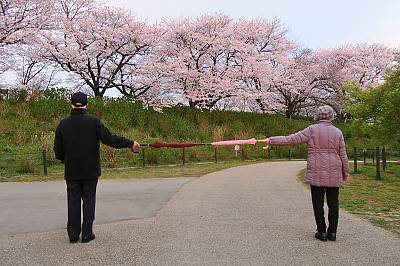The COVID-19 pandemic has already seriously affected various fields of intangible cultural heritage in Japan.
Issues concerning performing arts
In traditional performing arts, many performers can no longer perform and face financial difficulties as many theatres are closed.
Six national theatres including the National Theatre and the National Noh Theatre are all closed, the prospect of the resumption is not standing. These theatres play an important role as a venue for regular performances of traditional performing arts; therefore, the impact of their closure is critical.
Many private theatres are closed as well. Other elements of intangible cultural heritage related to traditional performing arts are also facing difficulties. For example, craftsmen who manufacture and repair musical instruments have continued to be out of work because the number of requests from performers has decreased dramatically.
One of the holders of the technique of making strings for stringed instruments said that if the situation continued for more than half a year, he would be forced to close his business.
On the other hand, there is also a movement to promote traditional performing arts online. The National Theatre has begun an attempt to release the video of the Kabuki performance held in March 2020 for free on YouTube.
The Shigeyama Sengoro family, the successors of the Okura school of Kyogen, is also making efforts at the private level, such as releasing live performances on YouTube from their home lessons for free.
Issues concerning traditional craftsmanship
Many practitioners of traditional craft techniques are also in trouble. Traditional Crafts Exhibitions sponsored by the Japan Crafts Association were important venues for artists and craftsmen of traditional crafts to showcase their works, but all the exhibitions are currently suspended.
In addition, most of the stores that sells traditional crafts are closed, and the opportunities for artists and craftsmen to earn income from selling their works have been greatly impaired.
Issues concerning social practices, rituals and festive events
Rituals and festive events practiced by local communities are also missing the opportunity to perform. For example, it was decided that the event of Yamahoko floats procession at the Kyoto Gion Festival (inscribed on the Representative List) will be cancelled. Originally, the event took place in the summer that began in the 9th century in hopes of resolving the plague. It is ironic that it will be discontinued due to the plague.
Every year, about 1 million domestic and foreign tourists visit Kyoto during the Gion Festival, so it is expected that this cancellation will also seriously damage the tourism industry. Not only large-scale festivals such as Gion Festival in Kyoto, the cancellations of rituals and festive events practiced in local communities have serious impacts on the resilience of local communities.
Many rural areas suffer from an ageing population and the outflow of the youth population; however, the rituals and festive events that are held during the season of rice planting in the spring, the orchid bon festival in the summer, and the harvest in the autumn are opportunities for young people in the city to come home. Because of the difficulty of young people in the city to return to their hometowns due to the pandemic, opportunities to perform and pass on these practices are being lost.
There are also, however, moves to confront the pandemic by utilizing the intangible cultural heritage of local communities. For example, in Iwate Prefecture, a traditional folk performing art called “Onikenbai” was performed to pray for the plague to subside on April 19. However, in order to avoid the risk of infection, 18 groups conducted demonstrations in front of the public halls in their respective villages rather than to congregate one place and distributed charms for repelling the plague to local residents.
Relevant links
Video of Kabuki performance provided by the National Theatre: https://www.youtube.com/watch?v=az2wWl4AY9U
Video of Kyogen performance provided by Shigeyama Sengoro family: https://www.youtube.com/watch?v=lw6OXeFvtJk
Video of “Onikenbai” performance that was carrid out on April 19 to fight against the plague: https://twitter.com/i/broadcasts/1ynJOpOjyArxR
Las designaciones utilizadas y la presentación de los textos y documentos presentados en esta plataforma no suponen ninguna toma de posición por parte de la UNESCO acerca de la condición jurídica de los países, territorios, ciudades o zonas ni respecto al trazado de sus fronteras o límites.
